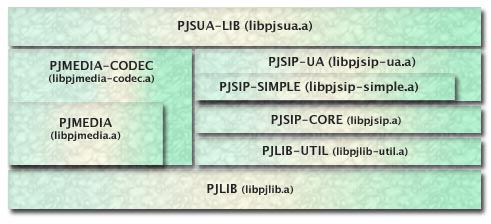|
|
|
|
Home --> Documentations --> PJSIP Reference PJSIP - Open Source SIP Stack
IntroductionPJSIP is an Open Source SIP prototol stack, designed to be very small in footprint, have high performance, and very flexible. HistoryPJSIP has been actively developed since 2003, but its history goes well beyond that. The author has been developing SIP stack since 1999 during RFC 2543 era, and after several experimentation with different approaches in the programming (the first stack actually was in C++!), and also with the evolution of the SIP protocol itself, the current/third generation of PJSIP (the 0.2.9 version is the second generation) can be considered as pretty stable in term of design, and should incorporate all design considerations (and implementation tricks!) that have been learned over the years. Of course only time will tell if this statement can still be held true in the future.
Getting StartedPJSIP consists of multiple levels of APIs, which each of them layered on top of another. Because of this, new readers may find it a bit difficult to find the place to start. In general, I think perhaps I can recommend two approaches on using PJSIP.
Using PJSUA APIPJSUA API - High Level Softphone API wraps together all SIP components and media into a high level API, suitable for creating typical SIP user agent applications. It features easy to use API for:
while maintaining some space for customization (custom SIP transport, custom SIP media, etc.) needed by some types of applications. PJSUA API - High Level Softphone API is also aimed to be able to run on devices such as PDA or mobile phones, by carefully allowing application to set the appropriate threading strategy and memory limits (number of calls, media ports, etc.). However, PJSUA API - High Level Softphone API may not be the most suitable API for some types of applications, since it is directed towards an easy to use API. For more more advanced use, you may better implement the application by using PJSIP + PJMEDIA directly, as described below.
Using PJSIP and PJMEDIA DirectlyFor the ultimate flexibility and power, using PJSIP and PJMEDIA directly is the way to go. The drawback will be, of course, steeper learning curve. However, the following links may provide some useful information:
About This DocumentThis document contains the reference information about PJSIP. For more in-depth guide (and information in general), readers are encouraged to read the PJSIP Developer's Guide PDF document which can be downloaded from http://www.pjsip.org/docs.htm.
How to Read This DocumentFor main navigation, please go to Modules link on top of this page. This document was generated with Doxygen from PJSIP header files.
Documentation ContentsClick on Modules link on top of this page to get the detailed table of contents. The following are top level sections in the Modules, as laid out in the following diagram: 
Static Library Layout Enumerating the static libraries from the bottom:
Copyright (C) 2006-2008 Teluu Inc. |
